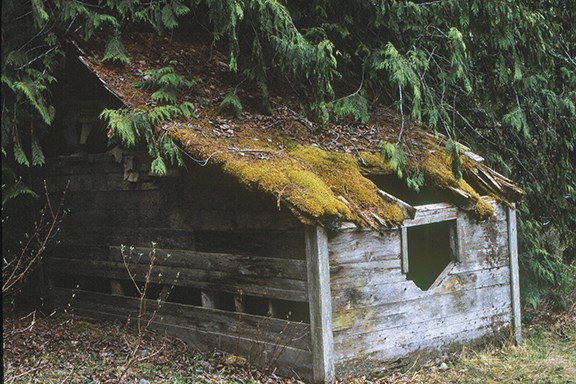Two new exhibitions sharing the Doris Crowston Gallery at the Arts Centre in Sechelt are a feast for the eyes – and ears.
At the Edge of Wilderness, by Vancouver’s Hildegard Westerkamp, and Altered States, by the Sunshine Coast’s Alan Sirulnikoff and Richard Nelson, use photography, audio and video to capture and reveal nature in ways we might not have looked at or listened to before.
Westerkamp’s work is a sound-slide installation about ghost towns in British Columbia, specifically in the Kootenays, with photographs by Florence Debeugny and audio technology by Roberts Creek maestro Giorgio Magnanesi.
Westerkamp told Coast Reporter she first encountered abandoned mining towns after arriving in Canada from Germany in the late 1960s. “Coming from Europe, it was totally fascinating to be in a wilderness environment. We used to go hiking and we’d come upon these junk heaps where people had lived,” Westerkamp said. “I was always stunned by the magic of that and also the environmental disaster that happened.”
Westerkamp said At the Edge of Wilderness was originally created 20 years ago and was exhibited in Vancouver as a work with images generated by five slide projectors accompanied by the 52-minute soundscape she had composed. Those slides and her highly imaginative and complex audio track have now been combined into a multi-image video presentation projected onto the gallery’s large film screen. The sound is reproduced by eight wood-panel speakers created by Magnanesi that surround the viewing area and provide a truly immersive experience.
“I perceive it as a thought piece about this phenomenon of industry, cutting into the wilderness,” said Westerkamp. “It’s so interesting to see traces of former culture. And yet really, when you think about it, and industrially and environmentally speaking, it’s an absolute garbage dump. They’ve left and they have not cleaned up. The tailings are still in the water. I’m not actually political about it. I’m just presenting it and saying, ‘OK, this is what we’ve got. And this is how we react to it. Let’s look at that.’”
At the other end of the gallery, video, sound-artist and musician Richard Nelson has taken Sirulnikoff’s deeply affecting photographs, many of which are separately on display, and created mesmerizing video and audio collages. Among them are the videos Still Life, and Altered Spaces. Production of the newest film, Altered States, was unavoidably delayed over the summer and is still a work in progress, but will become part of the exhibition soon, Nelson explained.
Sirulnikoff’s work, widely shown for nearly 20 years on the Coast and in the Lower Mainland and Interior, is a tribute to what in the digital age might be called “old-school” photography – using slide film developed at a Vancouver lab, then scanned and transferred onto photographic paper using Light Jet emulsion printers. “You get a very different depth to the image,” said Sirulnikoff.
The images indeed are deep, and meticulously captured – most of them in natural light – and expertly reproduced, revealing shapes and formations that can shift the sense of a photo while you’re poring over it. You might never look at desiccated flowers, seed pods or driftwood quite the same again. Other visual themes are also explored in the range of work in the exhibition’s videos. “But for me, they all fit under this heading of ‘altered states,’” Sirulnikoff said. “It’s interesting that these different specific projects I’ve worked on for many years seem to come together.”
Altered States and At the Edge of Wilderness are on at the Arts Centre until Oct. 4.



